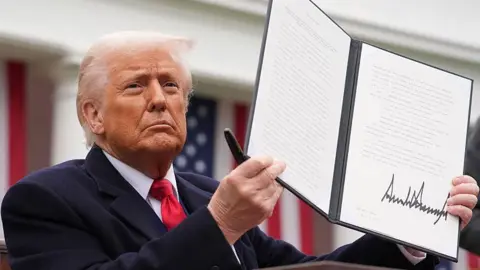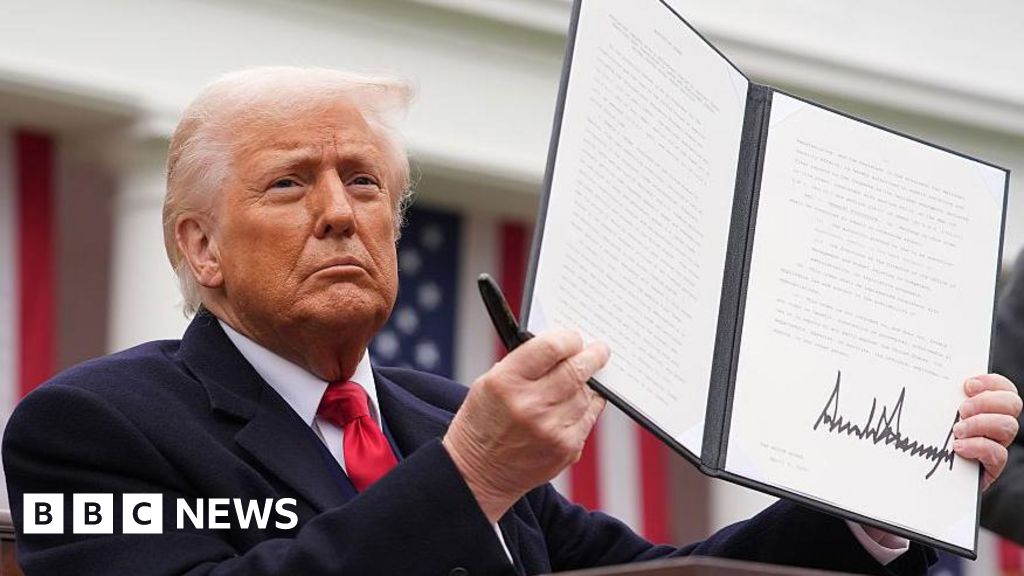 Getty Images
Getty ImagesJapan is a big deal for President Donald Trump’s dramatic changes in the global trade system.
In his own words, he can say that his positive approach has brought about concrete results.
From the off, the US side has been talking about the possibility of dealing with Japan, but despite several delegations, the deal has been oddly elusive – up until now.
In a narrow sense, this is a victory for Trump’s approach. Especially when Japan becomes a domino that lists other parts of the world.
Japan currently has the best deal, or rather the worst, contract of all countries with a major trade surplus with the United States.
The general tariffs of 15% charged on Japanese goods imported into the US are higher than the UK’s 10%, but there is no surplus in the UK.
As previously reported, the anger of Japanese negotiators during consultations was recognized as accustomed to the country’s extreme politeness among Washington, D.C. diplomats.
Tokyo was playing hardball. The Japanese Finance Minister described the $1.1 trillion holdings of the world’s largest US Treasury as a “card” that can be placed on the table.
Following Trump’s “liberation day” tariff announcement in April, there were rumors about the sale of U.S. Treasury hedge funds sparking wider sales and bigger questions about the world’s largest economy and the status of the US dollar’s safe haven.
Therefore, the arrival of a transaction is very important in itself and is important as an example of other major economic blocs, including the European Union (EU).
This transaction will be held on the day by the Japanese host EU leader in Tokyo. There have been some chatter about Japan, the EU and Canada coordinating retaliation. This will halt such initiatives.
Some EU members will probably wonder why similar deals are not being fired the moment Germany and France rise before retaliation against the US tech giant.
The world awaits details here, but it is clear that Japan is protecting agricultural imports, but it is clear that it will import US rice.
Japanese private companies will be supported in some way to invest $5 trillion in the United States, but it is unclear what can change the lack of popularity of large American cars in the country.
Japan made the deal when Trump’s stricter tariffs on many countries came into effect on August 1, when it was waiting to see how things developed and the international market reacted.
Other countries, including Indonesia and the Philippines, have also made dealing, but the prime minister’s domestic political weakness may have been a factor.
But the big picture is the tired acceptance of the US, fearing something worse, and collecting tariffs on major allies that could not be thought of a year ago.
In Japan, it was a 25% tariff threatened by Trump.
US tariff revenues are rising
The tariffs are currently collecting a substantial amount of the US Treasury without retaliation against US exporters. This year, it has been more than $100 million so far, with around 5% of US federal revenue coming from tariffs, usually more than 2%.
US Treasury Secretary Scott Bescent believes annual tariffs will be $300 million.
That’s far off the amount raised by income tax, but it’s a noticeable amount. It has been done without direct retaliation and now market turmoil has been seen before.
However, the story doesn’t end here. Who is actually paying these duties? U.S. consumers pay most of the price they pay for imports.
In the past, Bescent and others have suggested that rising US dollar value can help reduce consumer import costs. The opposite happened.
The dollar fell in the first half of this year, losing 10% of its value against a basket of world currencies. This adds import costs in addition to customs duties.
There is also a wide canvas here. Bank of England Governor Andrew Bailey said this week that “the busiest trade on the market at this time is the “short dollars.”
He added that the market, particularly the safe shelter pattern of the US dollar, has been established as “essentially broken.”
Now there is a “reducing exposure” to the dollar, as businesses and traders draw out trade and draw out “hedges” designed to protect them from its decline,” the governor said.
As discussed previously, there is doubt in the market that this weak dollar may actually be part of the points of these interventions.
In addition to that, the US helped its great rival China make a claim to at least the rest of the world.
In this first phase of the great World Trade War, Japan is a key victory for the White House and opposes the proposal that “Trump always kicked out the chickens.”
And while it could lead to a more obvious victory ahead of next week’s deadline, promoting further market well-being will remain far more intense in the wider economic situation.
